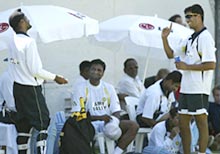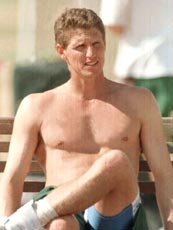Home > Cricket > Diary
Tour of duty
Faisal Shariff |
May 20, 2003

90,440 kilometers (56,194 miles), five continents, 55 one-day internationals and 16 Tests; 135 playing days and double that many practice days…
That was India's cricket schedule, beginning January 2002.
Of approximately 480 days since January 1, 2002, the Indian team travelled and played for 337 days. It won two overseas Tests, in the West Indies and England; won the NatWest triangular series, chasing a record 325 runs against England in England; was joint winners of the ICC Champions Trophy with Sri Lanka, and finished runners-up to Australia in the World Cup in South Africa. It also shared the winner's trophy with South Africa in the meaningless triangular in Bangladesh. 
The gypsy team, which used 30 different players during this time in which it travelled three-and-a-half times the earth's circumference, and has finally come home for some real rest in 14 months.
The punishing schedule merits comparison with that of Australia, which, in the same time span, went through 96 playing days, carefully spaced out to give its players sufficient time for rest and recuperation.
They have no doubt travelled more than the Indian team, traversing something like 90853 kilometres since January 1 2002. Though they have played the same amount of cricket during this period (50 ODIs and 16 Tests), their schedule has been well spread out. It is worth noting that despite its far easier schedule, the Australians have suffered more than their fair share of injuries in recent times, with ace seam bowlers Jason Gillespie and Glenn McGrath and star batsman Damien Martyn leading the list.
India, despite the Herculean efforts of physical trainer Adrian Le Roux and physiotherapist Andrew Leipus, have key players in various stages of disrepair: Sachin Tendulkar (chipped bone in his left hand ring finger), Rahul Dravid (hurt his middle finger of his left hand, while keeping during the World Cup semi-final against Kenya), Ashish Nehra (ankle surgery), Zaheer Khan (hamstring injury), Harbhajan Singh (finger injury) and Sourav Ganguly (back injury).
The board, as always, has been motivated by money and the needs of television producers -- but, maybe, it is time to pause and ruminate on a fact of life: if you kill the golden goose, all you get is a dead one!
A bowling coach
Since last year there was talk of hiring a bowling coach for the Indian team. South Africa's Fanie De Villiers, and Australians Terry Alderman and Carl Rackeman were the names that did the rounds.
 On India's last tour of South Africa, Fanie worked with the Indian bowlers and expressed an inclination for the job. Assessing the current Indian bowling attack, he had said that though the young crop is good they are still not there to tell the seniors they are not needed around any more.
On India's last tour of South Africa, Fanie worked with the Indian bowlers and expressed an inclination for the job. Assessing the current Indian bowling attack, he had said that though the young crop is good they are still not there to tell the seniors they are not needed around any more.
"They are not good enough to take over yet. (John) Wright is right; they need a bowling coach with him. That's why he wanted me," he had said.
He added, "I believe that I cannot only make a difference but I can make a hell of a lot of difference. Fast bowling is not fitness alone. It is also about cardio-vascular endurance and muscular endurance. And they are just two of the six or seven vital components. If you don't look after that, you won't have a strong bowling attack. You can't afford injuries. That is the blueprint that must be in place."
"Why does Pakistan produce so many fast bowlers and India none? Because the knowledge of Imran Khan has gone into Wasim Akram and Waqar Younis and from them into Shoaib Akhtar and the other bowlers. The board must put such a system in place. We need facilitators in India."
With Javagal Srinath having made it clear that he would not play Test cricket for India, and signing up for South Africa's provincial side Guateng as bowler and coach, it is important that India goes in for a bowling coach. Though Wright is doing a great job as coach, he is not an expert on wrist-position and on the subtle variations of bowling, which could benefit young fast bowlers.
"Instead of wasting money on an assistant coach with vested interests it is important that we have a bowling coach to help the young bowlers prepare for the tour of Australia," said a senior player.
Indeed, it is intriguing why Srinath was not approached by the BCCI to work with the young bowlers. It seems the Board is more worried about the health of spin in the country. In fact, it is now busy organising a spin seminar, for which it has invited all the former spin greats for a brainstorming session in Kolkata on May 30.
BCCI president Jagmohan Dalmiya said despite being traditionally strong in the spin department, the performance of Indian slow bowlers of late, with the exception of off-spinner Harbhajan Singh and leggie Anil Kumble, has not been up to the mark.
"Spin bowling appears to be a decaying art today. In the past, however, the strength in this department helped India win many matches. But the performance of the spinners with the exception of Kumble and Harbhajan leaves much to be desired," he had said, while announcing the formation of a panel of spin stalwarts.
Maybe, it would be interesting to ask the BCCI chief what he plans to do about the state of pitches in the country and when he plans to implement the recommendations of the New Zealand Sports Turf Institute.
Shouldn't progressive measures, besides being cosmetic and populist, also be effective?
The Rediff Diary -- the complete archives